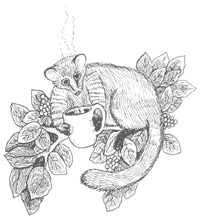STRANGE BUT TRUE- Tastes like... Don't say it; just enjoy!

DRAWING BY DEBORAH DERR McCLINTOCK
Q. On the world's menu are dung-driven coffee, saliva soup, maggot cheese, and more. Are these foods "in bad taste," or are they delicacies? –A. Bourdain
A. They're the latter, as described by Dr. Massimo Marcone in In Bad Taste? The Adventures and Science Behind Food Delicacies. Take "Kopi Luwak," Indonesian for coffee and civet, from the island of Sumatra where the arboreal catlike palm civet consumes the sweet, ripe red coffee cherries with beans inside. After being "deposited," these are collected, washed, and roasted, producing a chocolaty "cat-scat" coffee selling for over $1,300 US per kilo ($600/pound), "rarest and most expensive beverage anywhere."
Edible birds' nests derive from the Indonesian male swiftlet that builds its home in caves using strands of sticky saliva. After cleaning, the nests are air-dried and packaged for sale around the world. When cooked in water or chicken broth with rock sugar, the "saliva soup" at $80-$100 per bowl tastes and textures like tapioca pudding.
For some "Casu Frazigu" (maggot cheese), head to Sardinia where it originated. As the sheep-milk cheese ages, fly larvae spread throughout, excreting digestive enzymes that give it its creamy texture. When Marcone first encountered the cheese, he was struck by "the clicking sound of thousands of tiny maggots hitting the container sides, audible from six meters (20 feet) away."
Traditionally served as a spread on flatbread, it's popular at Italian weddings and other special occasions.
Want more? Then you might go in search of ant-egg caviar, poison-scorpion soup, water beetles sauteed in argan (goat-dung) oil... Bon appetit!
Q. Have you heard the one about how if you leave a fan running overnight with the door and windows shut, you can suffocate as the fan uses up the oxygen and produces lethal amounts of carbon dioxide? Dozens of people are said to have perished. This particular "urban legend" has circulated in South Korea; most South Koreans don't believe a word of it but still keep it alive, so what's the point? –L. Myung-Bak
A. Every culture has its share of word-of-mouth nonsense, says New Scientist magazine, but it actually has a deeper purpose: storytelling. Urban legends, for all their implausibility, keep the listeners' attention. They entertain, thereby enhancing social relationships, note researchers at New Zealand's University of Waikata.
"Lots of us love to have a rapt audience even if that means spouting garbage," they say. So it's little wonder the yuckiest, grisliest tall tales are the ones that survive.
Fan death fits perfectly here, with its unexpected dangers and gruesome end. So next time you want to bond with the group, why not ask if anyone's heard about the flesh-eating worms that live inside baked beans, or the umpteen deadly diseases lurking on the average train seat?
Q. It was the strangest creature they'd ever seen, with no eyes or mouth or any obvious organ for ingesting food or secreting waste, plus no means of locomotion. It was no snake or eel but no plant either. So what was it? –J. Cousteau
A. A "sublimely colored" giant tube worm living near a hydrothermal vent in the eastern Pacific, says Dr. Daniel Desbruyeres in The Deep: The Extraordinary Creatures of the Abyss. The year was 1977 when the U.S. submersible "Alvin" dove to a depth of 2500 meters (8200 feet) over the Galapagos Ridge. "Isn't the deep ocean supposed to be like a desert?" exclaimed geologist John Corliss to the surface crew. "Well, there's all these animals down here."
This was the first discovery of hydrothermal vents, deep ocean heat sources giving rise to a profusion of weird life forms based not on photosynthesis but chemosynthesis, largely independent of sunlight. It was like dropping a bomb in the scientists' world, revolutionizing biology. Quite likely the first molecules of life were synthesized there, says Desbruyeres. This scenario is used as an argument for searching for life elsewhere, like on the Jupiter moon Europa. "The idea of extraterrestrial life, but in the form of microorganisms and not of fantasized Martians," he says, "is no longer eccentric or improbable."
Q. Why is it that September, October, November, and December are the 9th, 10th, 11th and 12th months of the year when their etymological roots suggest they should be the 7th, 8th, 9th and 10th? –J. Brinkley
A. In fact they were 7th, 8th, 9th and 10th for the ancient Romans, whose 10-month calendar began with Martius, then Aprilis, Maius, Junius, Quintilis, Sextilis, September, October, November, December, says ScienceWorld at wolfram.com. The last six obviously contain the Latin roots for the numerals.
But the 10 months accounted for only 304 days, with an unnamed period afterward in winter. Later, January and February were introduced at the top, rounding out what eventually became the 12-month Gregorian calendar but throwing off monthly nomenclature.
Actually, many different calendars have been used, some 40 of them still employed around the world, particularly for determining religious events, says Webexhibits.org. Ours is based on the apparent motion of the sun around the Earth, while the Islamic calendar looks to the motion of the Moon and the Jewish calendar links to both. "Most modern countries use the Gregorian calendar for their official activities."
Send Strange questions to brothers Bill and Rich at [email protected].
#